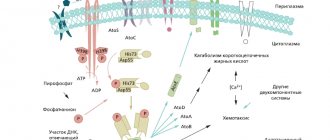Mom's life is difficult. Feed, wash, change, play, put to bed. But life for a toddler is even more difficult. New world, new sensations, new problems. And the beginning of life does not always proceed without health problems.
Intestinal colic due to imperfections of the digestive system is not so bad. But often the birth is accompanied by various conditions for which antibiotics and other aggressive substances are indicated. And the microflora that has not yet been properly formed dies irrevocably, giving rise to new problems with the gastrointestinal tract, dysbacteriosis in the oral cavity and genitals.
To restore the microflora, children are prescribed the drug “Hilak Forte”. How to give Hilak Forte to a newborn?
Composition, pharmaceutical group, mechanism of action
Hilak forte normalizes the composition and quality of beneficial microorganisms.
This medicine belongs to a group of drugs that affect the microflora of the body. Hilak
Forte is produced only in the form of yellowish drops. The smell is pungent, slightly sour. This is not a sign of damage. The drops contain substrates of cultures living in the human gastrointestinal tract:
- Escherichia coli
- Enterobacteriaceae
- Lactobacilli 2 species
- Additional substances - lactic and phosphoric acids, sodium and potassium salts
- The drug is produced in 2 packages - 30 ml and 100 ml. Dark glass bottles with a dropper.
The microflora of the intestines, mouth, and genitals reacts sensitively to changes in the living conditions of its owner. Antibiotics, sulfonamides, even stress and the body reacts with the death of beneficial bacteria. At the same time, opportunistic flora, which is a habitual inhabitant of the body, begins to multiply. Inflammatory processes occur and general immunity decreases.
The components of Hilak Forte normalize the composition and quality of beneficial microorganisms.
Additional components - acids and salts - bring the pH of gastric juice to normal levels, regardless of its initial acidity. As a result, the body independently resumes the synthesis of B vitamins and vitamin K, and the body’s overall resistance to infectious diseases increases.
In infants of the first year of life diagnosed with salmonella enteritis, the drug promotes accelerated removal of the pathogen from the body and replacement of opportunistic flora with normal acidophilic flora.
Cost of medicines
The medicine is marketed in the form of oral drops. The average cost of a bottle (30 ml) is 270 rubles, and 100 ml – 550 rubles. Today you can buy an equally high-quality analogue of Hilak Forte much cheaper.
| Drug name | Cost (in rubles) |
| Bifidumbacterin | 110 |
| Acipol | 190 |
| Enterol | 250 |
| Acylact | 99 |
| Profibor | 122 |
The cost of medications depends on the dosage and country of origin. Imported drugs will cost slightly more. If there is a need to replace the main product, you should consult a doctor. The selection of analogues can only be carried out by a qualified specialist.
When should you take the drug?
Hilak forte is used to treat gastritis.
This drug is used in the treatment of diseases associated with an imbalance in the ratio of beneficial and pathogenic microorganisms. The drug is indicated in the following cases:
- Changes in microflora due to aggressive treatment of any disease, radiation, stressful situation
- Dyspeptic problems - constipation, diarrhea, flatulence, belching, nausea
- Inflammatory diseases of the gastrointestinal tract - gastritis, enteritis, colitis
- Pathologies of the liver, biliary tract
- Allergies - hives, rashes, eczema, provoked by external irritants
- Salmonellosis during the recovery period
There is only one contraindication for treatment - individual intolerance to the components of Hilak Forte drops. Pregnancy and breastfeeding are not considered a contraindication, but a doctor must decide whether to prescribe the drug.
Side effects when using the drug occur extremely rarely. Allergic reactions and defecation disorders, both constipation and diarrhea, have been reported in the literature. All unpleasant phenomena went away on their own after discontinuation of the drug.
Hilak forte or Bifiform - which is better?
Manufacturer: Pfizer, Italy Release form: capsules, drops Active ingredient: enterococcus, bifidobacteria
Hilak Forte and Bifiform are high-quality foreign analogues used in children, infancy and adulthood. The first drug has one release form - drops packaged in a sachet or bottle. The second is capsules and drops for children.
Significant difference - Bifiform contains live bifidobacteria and enterococci. Hilak forte is a metabiotic, contains waste products of beneficial bacteria and lactic acid.
No studies have been conducted to compare the effectiveness of these drugs. However, according to guidelines for doctors, metabiotics (Hilak forte) are more effective than probiotics (Bifiform). The choice of analogue is made based on indications, financial capabilities, preferences regarding time and frequency of administration, and even taste.
Dosages for infants and not so
Hilak Forte can be taken even by children.
The effective therapeutic dose is determined by the attending physician, based on the age and diagnosis of the patient:
- Toddlers 1 year of age – from 15 to 30 drops 3 times a day
- Children aged one year and older – from 20 to 40 drops 3 times a day
- From 18 years and older – from 40 to 60 drops 3 times a day
If the general condition improves, it is recommended to reduce the volume of the drug by 2 times. Hilak Forte should be washed down with water, juice or tea. Milk is prohibited. The drug is taken regardless of the last meal.
Symptoms of overdose are not described in the literature. Treatment in this case is not required. Dynamic monitoring of the patient's condition is sufficient.
Foreign analogues
In addition to Russian-made drugs, a list of foreign substitutes for the main drug is highlighted, which have a similar effect on CM. They are produced by well-known manufacturing companies, and therefore are characterized by a high degree of efficiency.
Bactisubtil
A medication from a group of drugs intended to eliminate intestinal dysfunction. The combined product contains:
- Kaolin.
- Spores of Bacillus cereus IP 5832.
- Calcium carbonate.
The eubiotic helps suppress the proliferation of pathogenic bacteria and has antidiarrheal and antimicrobial properties.
Prescribed for the following diseases:
- dysbacteriosis;
- enterocolitis;
- enteritis;
- chronic or acute diarrhea;
- carrying out preventive methods aimed at normalizing the functioning of the gastrointestinal tract after a course of chemotherapy.
It is prescribed for children and adults because it does not cause side effects and has virtually no contraindications. In case of individual intolerance to the components, an allergic rash, anaphylactic shock, and Quincke's edema may occur.
The instructions from the manufacturer indicate that adult patients need to take two capsules 2 to 4 times a day. The exact dosage should be based on the characteristics of the pathology and determined by the attending physician.
Baktisubtil and the original drug have similar indications for use and are well tolerated by patients. They differ in composition.
Lacidophilus
Lacidophil is a medicinal product, the main substance of which is lyophilized cells of lactic acid bacteria. Helps normalize CM, increase local immunity, and improve the digestion process. Under its influence, the degree of tolerance to lactose increases and allergization of the entire body decreases.
Lacidofil is used to treat newborns and adults with the following conditions:
- gastroenteritis;
- diarrhea;
- intestinal dysfunction;
- atopic dermatitis;
- constipation;
- dyspepsia.
The advantage of this medication is the absence of contraindications and adverse reactions.
Capsules are taken with meals. As a preventative measure, take one capsule once a day. To eliminate unpleasant symptoms of intestinal dysfunction, 1-2 capsules are prescribed once a day.
Dosage forms belong to the same pharmacological group. This means that they have a similar effect and can act as substitutes for each other. The main medication has a wider spectrum of action and list of indications.
Linex
One of the most popular substitutes for Hilak. The active component of this eubiotic is viable lyophilized fermented milk bacteria (Enterococcus faecium, Lactobacillus acidophilus, Bifidobacterium infantis).
It has antidiarrheal properties and normalizes the functioning of the gastrointestinal tract. Under the influence of the drug, an increase in the protective functions of the body, inhibition and growth of pathogenic bacilli, synthesis of antibacterial active substances, and breakdown of complex carbohydrates, proteins and fats are observed.
Drugs are prescribed in the following cases:
- Long-term use of antibiotics.
- Bacterial or viral infection of the digestive tract.
- Dysbacteriosis.
Should not be taken by patients with individual intolerance to components or lactose.
Take the drug immediately after meals. Children - 1 capsule three times a day, adolescents are prescribed an adult dose - two capsules. There should be three doses per day. To date, there is no information regarding the side effects of the drug.
Medicines differ in their active substances. At the same time, they have a positive effect on digestion and intestines.
Narine
The dietary supplement consists of acidophilic lactic acid bacteria. The main action is aimed at eliminating bacteriosis and its consequences. The drug is also effective for infectious pathologies of the vagina.
The supplement is prescribed for the following diseases:
- eczema;
- dysentery;
- staphylococcal infection;
- neurodermatitis;
- diabetes;
- salmonellosis;
- exudative diathesis;
- atopic dermatitis;
- enterocolitis.
Before you start taking the medication, you must make sure that the patient is not allergic to its components.
Well tolerated. In rare cases, newborns may have more frequent stools. This phenomenon does not require treatment and goes away on its own.
Capsules and tablets are prescribed to patients from 3 years of age. Children are recommended to take one capsule three times a day. The adult dose is 200-300 mg three times every 24 hours.
Narine is a dietary supplement that is taken with meals. Just like Hilak, the drug has a positive effect on the gastrointestinal tract and digestive process, despite the different components.
Enterol
Lyophilized Saccharomyces boulardii is used as the main active ingredient in this antimicrobial and antidiarrheal drug. The substance acts as an antagonist of pathogenic/opportunistic bacteria. Helps increase sucrase, lactase, maltase. Due to the action of the medication, the enzymatic functions of the intestines also increase.
Prescribed for diarrhea, regardless of its etiology, irritable bowel syndrome, rotavirus infections. This drug should not be used by pregnant women, people with allergies, or used to treat babies under one year of age. The most common adverse reactions include an allergic rash and pain in the stomach. The adult single dose is 1-2 capsules twice a day.
The original medicine is based on other components, but has a similar effect on the body, so the choice depends on personal preference.
special instructions
During treatment you should follow a number of recommendations:
- Do not drink Hilak Forte with milk, dairy or fermented milk products
- Do not take antacids, as they neutralize the acids that make up Hilak Forte.
- An open bottle should be stored for no more than 1.5 months.
- The drug does not require special storage conditions. It is enough to adhere to the temperature regime – from +4 to +25 degrees Celsius.
Contraindications and adverse reactions
Hilak Forte is well tolerated by children and adults. During treatment, allergic reactions to the skin and mucous membranes rarely occur. Isolated cases of diarrhea and nausea were recorded.
The instructions indicate that the medicine can be given to children over 2 years of age. But doctors often prescribe the drug to infants. No negative reactions were recorded.
Drops should not be taken by people with hypersensitivity to the ingredients of the drug, acute diarrhea, or the presence of blood in the stool. The metabiotic is contraindicated if there is a history of lactose intolerance, Lapp lactase deficiency, or glucose-galactose malabsorption.
Hilak should not be used simultaneously with antacid medications. Antacids destroy lactic acid, which is a component of the drops.
Advice from a nutritionist for lactose and milk intolerance
“Why do I have such a reaction to milk?” — it is with this question that patients very often come to visit a gastroenterologist. Let's find out!
Milk is an emulsion, and therefore, due to its physical properties, it is a very favorable product for the digestive tract. It has viscosity and enveloping properties, which often has a good effect on the digestive system and the body as a whole.
Milk is a multicomponent product: proteins, fats, carbohydrates. There are as many sides to a product as there are so many possible problems. Complaints about fat content are usually rare, but the carbohydrate composition most often causes complaints, mainly due to the main sugar of milk - lactose!
Lactose intolerance (lactase deficiency) in adults is a fairly common phenomenon and depends both on hereditary predisposition and on the place of residence and tradition of drinking milk. For example, in the northern regions of Europe, lactose intolerance in adults occurs in 25% of the population, and among the indigenous peoples of Africa, Southeast Asia, North and South America, living closer to the equator, its frequency reaches 95%.
Lactase deficiency in adults is divided into secondary and primary. Primary lactase deficiency can manifest itself in childhood and can develop with age. Secondary occurs under the influence of intestinal infections and other causes that cause damage to cells of the small intestine of various origins.
According to the degree of severity, it is divided into hypolactasia - partial enzyme deficiency, and alactasia - complete enzyme deficiency.
What is the difference between lactose and lactase?
Lactose (milk sugar) is a carbohydrate of organic origin, which consists of two molecules of glucose and galactose and is one of the main components of mammalian and human milk. In its undigested form, lactose cannot be absorbed by intestinal cells. Therefore, to assimilate it, a reaction is carried out in the small intestine that separates lactose into its components - glucose and galactose, which, penetrating the cells of the small intestine, enter the general bloodstream and then the liver. In the liver, they are used to synthesize and store glycogen, which is fuel for the processes occurring in our body.
Beneficial properties of lactose
- plays the role of a prebiotic, improving the composition of microflora;
- participates in the synthesis of B vitamins;
- affects the absorption of calcium, magnesium and other microelements and its own enzymatic activity;
- is a source of energy.
Lactase is a special enzyme that is produced by the cells of the small intestine and controls the reaction of lactose breakdown. When the production of this enzyme decreases or stops, undigested lactose enters the large intestine, where a fermentation reaction occurs with the participation of bacteria, which produces an abundance of gases. In addition, if the consumption of dairy products regularly causes loose stools or pain, cramps, then an inflammatory reaction is triggered, which in the future can lead to prolonged duodenitis or functional disorders of the gastrointestinal tract, changes in the intestinal microflora.
Symptoms of lactose intolerance
The main clinical symptoms are loose stools (diarrhea), bloating, as well as disturbances in the gastrointestinal tract that occur immediately or within 24 hours after drinking milk or dairy products.
In addition, in the presence of intestinal dysbiosis, substances formed during the microbial breakdown of lactose in the large intestine have a toxic effect and can cause general malaise, headaches and, according to some reports, even mental disorders.
People with lactose intolerance are concerned
- diarrhea and loose stools;
- rumbling in the intestines;
- flatulence;
- cramps and pain in the abdomen;
- nausea and vomiting;
- increased fatigue;
- weakness.
The intensity of symptoms depends on the quantity and amount of lactose obtained from food and lactase produced by the cells of the small intestine.
What foods contain lactose?
Milk and animal milk products naturally contain lactose, and many industrially manufactured products may contain added lactose. Any product containing milk, lactose, whey, cottage cheese, or milk powder contains lactose, so before purchasing products, you must familiarize yourself with the ingredients listed on its packaging.
Prepared foods that typically contain lactose include:
- cakes, cookies and pastries;
- cheese sauce;
- puree soups;
- custard;
- milk chocolate;
- pancakes;
- omelette;
- some types of mashed potatoes.
Some products may contain “hidden lactose” and its content may not be declared on the packaging. Examples of products with hidden lactose:
- granola bars;
- bread;
- breakfast cereals;
- margarine;
- some instant soups;
- lollipops, chocolates and chocolates;
- ham or sausage;
- sauce or salad dressing and mayonnaise.
About 20% of prescription drugs, such as birth control pills, and about 6% of over-the-counter drugs, such as those for heartburn, contain lactose. Therefore, people with lactose intolerance (especially alactasia) should tell their doctor about it when prescribing new medications.
How to replace milk if you are lactose intolerant?
Dairy products are a good and affordable source of calcium, proteins and vitamins. Therefore, people with lactose intolerance need to use alternative sources.
Some people with reduced lactase production retain some lactase activity and can include varying amounts of lactose in their diet without experiencing symptoms. For example, they have difficulty digesting fresh milk but eat certain dairy products, such as cheese or yogurt, without discomfort. These products are made using fermentation processes that break down most of the lactose in milk. In this case, yoghurts with live cultures, cheeses in which lactose has already been fermented by bacteria, or low-lactose dairy products are recommended.
If it is necessary to completely eliminate milk, you can use lactose-free milk, in which lactose has already been broken down into glucose and galactose, as well as its plant alternatives - nuts (almond, cashew, etc.), flaxseed, cereals (oatmeal, rice, buckwheat, etc.), coconut or soy milk. Grocery stores often offer a wide selection of lactose-free alternatives to various foods.
Instead of milk, you can add calcium sources of plant and animal origin to your diet:
- sesame;
- nuts and seeds;
- soy milk and cottage cheese;
- legumes;
- greens - dill, parsley;
- fatty fish such as salmon, tuna and mackerel;
- eggs.
Alternative sources of vitamin A include:
- carrots, broccoli, sweet potatoes, pumpkin,
- melon, apricot, papaya, mango;
- legumes;
- liver, eggs.
Vitamin D levels can be increased through exposure to natural sunlight, fatty fish, eggs, fish oil and some fortified foods.
Basic principles of a lactose-free diet
For both primary and secondary lactose intolerance, a lactose-free diet is the mainstay of treatment. Successful adherence to it ensures recovery and cessation of disturbing symptoms.
The diet is selected individually depending on the severity of symptoms and involves limiting or excluding foods containing lactose from the diet. The duration of the diet also depends on the cause of the disorder and the severity of the symptoms. The amount of lactose that can be consumed without harm to health depends on the nature of the disorder. Many people have residual lactase enzyme activity, so everyone needs to determine their individual lactose tolerance threshold after consultation with their doctor.
When using a product with lactose, two factors are taken into account - the amount of milk sugar in it and its volume. To create a diet, it is convenient to use tables with lactose content per 100 g of product.
The basis of the diet for a lactose-free diet is products that do not contain lactose. Lactose-free dairy products are a good replacement for conventional products.
low-lactose dairy products :
- fatty foods - butter, cream;
- fermented foods - cheeses, yoghurts, fatty cottage cheese.
The higher the fat content, the lower the milk sugar content.
When preparing dishes, almond, soy, oat milk and any other plant-based drinks will help replace regular milk. Using alternative milk, you can make not only drinks, such as smoothies or cocktails, but also pancakes, omelettes, waffles and baked goods.
The diet of a person with lactose intolerance should be balanced and replenish the protein, vitamins and calcium that he is deprived of, excluding dairy products.
If you are concerned about symptoms of lactose intolerance, do not switch to a lactose-free diet without consulting your doctor. It is possible that these symptoms may be caused by other causes, and in particular inflammatory bowel disease. Food additives (enzymes containing lactase) can be an addition to the diet; they are taken in capsules or added to milk, or used in the home production of lactose-free fermented milk products.
Cow's milk protein food intolerance in adults
It remains to discuss the last facet of milk - protein . We will mainly discuss cow's milk protein as the most common protein consumed in our country.
Most often, it, as a “foreign” protein for our body, can trigger allergic reactions that are detected in childhood due to the brightness of the manifestations - rashes, skin itching, vomiting or Quincke's edema after consuming cow's milk or products made from it.
In adulthood, food intolerance to cow's milk protein is more common - this is a slow reaction of the immune system with sluggish, but no less inconvenient symptoms: bloating, unstable stool, cramps, pain, belching, mild periodic incomprehensible skin itching, general weakness, aching pain in the joints. In the case of this reaction, the main thing is that against the background of the symptom, local inflammation does not start - the gastrointestinal tract or systemic.
For these purposes, elimination diets or restriction in the consumption of certain food groups are used. The timing should be determined by a doctor; it is also important to prevent a lack of protein, vitamins D, calcium in the diet and to select the best available replacement for all components of cow's milk and fermented milk products made from it.
You can get advice from a nutritionist-gastroenterologist specializing in the management of patients with milk intolerance (lactase deficiency and milk protein food intolerance) at the Expert Gastroenterological Center. For express diagnostics of the above conditions, we suggest using the comprehensive LactoCheck program developed by the center’s specialists.





